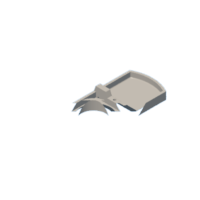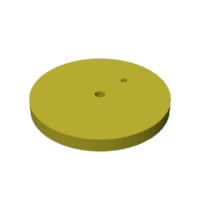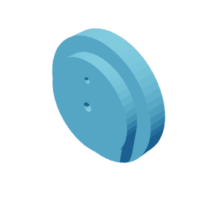Introduction: STIRLING ENGINE for Every One!
Instructions for building a simple Stirling engine. Suitable for everyone! A few ordinary objects are enough. A little skill, patience and a little time.
Jiří Lüftner
Supplies
Materials:
Tin Can 98 x 38 mm
3d printed parts
Thin latex glove
Steel wire 1 mm
Stainless steel pop rivet 4 x 12 mm
6 mm cardboard
CD disc
A nail with a diameter of 1.5 mm
Thread
Tools:
Hand drill
Steel drill set
Pliers
Knife
Shears
Hammer
Super glue
Tape
Sandpaper
Marker
Step 1: 3d Printed Parts
The next step is to print or have all the necessary parts printed on a 3D printer. In principle, it does not matter what material they will be printed from, because none of the parts are under any significant stress. Choose the color combination according to your personal preferences. Likewise, the printer model setting itself, each printer is different, and therefore always based on experience with the given machine, or don't be afraid to ask for help.
The printed parts will still need some care, but the following steps allow for that. It is also not necessary to simply measure the dimensions of the prints, if they fit within a reasonable tolerance (±1 mm).
Step 2: Holes in the Can
Now we move on to the manufacture of the working chamber of the engine, in our case, the can. Here, you first need to rinse and clean any dirt. Next, we take the lid of the can and attach the printout of the base (part 1) to it, so that it is centered and outline it completely. So we should see the outline of the base, a circle with a diameter of 30 mm and a center point on the lid.
Now comes the drill. The center point needs to be drilled with a 4 mm diameter drill bit. It is ideal to make a small hole in the point so that the drill does not move and does not press on the drill, and then also a few holes inside the large circle. Now take the sheet metal scissors in your hands and carefully, using the tip of the scissors, cut the entire circle so that there is an opening with an approximate diameter of 30 mm and both holes in the lid line up with part 1.
Step 3: Gluing the Base
When the previous step was successful, we can proceed further. For the actual gluing of part 1, the lid of the can. Both glued surfaces (bottom of part 1, lid of the can) must be roughened with sandpaper (thickness is not important). This will ensure a better adhesion of the glue.
Apply a sufficient layer of super glue to the tin lid and then attach part one so that the two holes line up and tighten properly so that the joint is perfectly tight. This is absolutely critical to the entire functionality of the engine, as even a small leak will cause it to malfunction.
Step 4: Cutting and Pasting the Second Part
We proceed further, to part number two. This part can either be printed, or it needs to be redrawn on the selected material (plywood or plastic board with a thickness of 3 mm), cut out with a saw, grind the edges and then drill a hole for the bearing.
We just glue this manufactured or printed part to the appropriate place, before roughing both glued surfaces again using sandpaper. Glue using instant glue.
Step 5: Allocation of Rivets
Subsequently, it was time to make the bearings. We will make these from two 4 x 12 stainless steel rivets, which we will tap with a hammer so that the shaft separates from the housing and thus. We have a shaft and a sliding bearing. A big advantage is their really low friction, although we can't talk much about accuracy, if necessary, small ball bearings can also be used.
We stick the first rivet case into the center hole of the can lid from below. We have to enlarge this hole with a 4 mm drill, and then insert it with the help of a larger amount of super glue. We always quickly wipe off excess glue with a napkin. Also, any fast-drying two-component glue can be used instead of super glue.
We just glue the second case into the prepared hole in part 2, according to the photo below.
Step 6: Flywheel
Next is the first moving part. We stick our CD into the printed part No. 3 with the help of super glue, making sure that it is attached really well and firmly. Next, we enlarge the central hole with a 2.5 mm drill bit and stick our axis into this hole so that one side is aligned with the edge of the flywheel. All that remains is to enlarge the hole for the first handle with a drill with a diameter of 1.5 mm and insert (do not glue) a shortened small nail into it.
Step 7: Crank
The flywheel and one crank are therefore finished, and we move to the other side of the shaft to the other crank. This is part number 4, which is again easy to assemble. It is necessary to drill the center hole again and again and glue the whole piece to the shaft so that the flywheel rotates, but there is no unnecessary play (a play of around 1 mm is ideal). It is important to make sure that the second handle is turned 90° from the other one. Then pinch the protruding part of the shaft and re-drill a hole into which, as on the other side, glue the shortened nail. Now it is enough to drip the oil so that it flows into the housing and the rotating part is ready.
Step 8: Membrane
Time to create a working engine piston - a diaphragm. We take a thin latex glove, from which we cut a square of material with an approximate side length of 40 mm. Subsequently, we roughen the front side of the circular hole on part 1 with sandpaper. We press the entire joint firmly and visually check the tightness.
Step 9: Connecting Rod
Now it's time to connect the diaphragm and the crank with the first connecting rod. First, we cut a circle of cardboard with a diameter of approximately 10 mm, stick it in the middle of the membrane using super glue. Next, we will prepare our wire, roughly a piece with a length of 100 mm. We stick one piece and then glue it to the cardboard part. We set the flywheel so that the first crank is horizontal with the center of the flywheel (i.e. halfway up) and we mark this position on our connecting rod with a marker. At this point, using the tip of the pliers, we bend the connecting rod so that it forms an eye that will sit on the nail. It is ideal to preheat the connecting rod in this place and then let it cool down slowly so that it can bend better (simple annealing). We insert the eye of the connecting rod over the nail, lubricate it with oil and the connection is complete. The diaphragm should move as the flywheel rotates.
Step 10: Displacer
The last big part is the displacer. We draw three circles with a diameter of 88 mm on cardboard with a thickness of approx. 6 mm, which we then cut out with a knife and glue together, it is possible to use instant glue or ordinary paper glue. In the center of the resulting cylinder, stick a tear rivet with the thick side, and the displacer is ready.
Step 11: Displace Connection
Now all that remains is to connect the displacer to the crank. First, we insert it through the center housing of the lid so that it fits all the way to the lid, and we set the crank to the top dead center (highest position). Now we will take a thread from a length of approx. 120 mm, tie a loop on one side, which will be put on the nail, and glue the other end to the tip of the rivet of the displace using instant glue. Now the displace should move up and down smoothly as you turn the flywheel.
Step 12: Preparation Before Running
Last preparations before the run:
• Check that the engine runs smoothly and does not rub anywhere, remove any defects.
• Drip oil on all steel contact points.
• Secure the joint between the lid and the can with insulating tape.
• Make sure the overdrive slides down smoothly and that all connections are tight.
• Pour some water into the tub of part 1 as a coolant.
Step 13: Running
Now all that's left is to warm up the engine from the bottom and push it for the first time and then just enjoy the run of the engine you just built yourself! A suitable heat source is any candle or lighter, or even a mug of boiling water, which offers a limited running time. Also, don't forget about safety when handling an open fire, always have water at hand to put out any fire!
Step 14: Why Isn't It Running?
Two main reasons are offered:
• LEAKAGE – Air is most likely leaking from the engine somewhere, so check the connection of the cover with part 1 and, if necessary, seal it with glue or silicone.
• EXCESSIVE FRICTION - Check that your engine is able to spin using inertia for at least the next 4 seconds after spinning the flywheel. If not, focus on all parts and try to minimize friction and all kinds of rubbing.
Step 15: Engine Modifications
The simple design of the motor itself offers the possibility of user adaptation and optimization of the design, or possibly the further development of a whole new machine design.
There are several options where to direct the further development of the engine:
• Changing the material of the overheater from cardboard to a regeneration material such as fine steel wool.
• Optimization of the engine crank mechanism.
• Ensuring insulation between the hot and cold sides of the engine
• Addition of active cooling.
Step 16: Alternative Version Without 3d Printing
Don't despair if you don't have access to 3D printing or just don't want to use it. The whole model can also be built without it. The construction will be a little more demanding, but nothing that could not be handled at home with a little skill.
Basically it's just a replacement of the printed base (part 1) and parts of the crank mechanism.
Base production
According to the attached documentation, the main part of the base is cut out of 3 mm plywood or plastic board, on which the membrane is stuck. For cutting, it is optimal to use a jigsaw and then sand the part with sandpaper. For the gluing itself, we will use second glue.
During the subsequent connection of part two, we will use some support for the joint (so-called "ventilation"), for example a piece of wooden prism, which will strengthen the joint.
Next steps
All further production is purely in your hands. Inspiration can be taken from the manufacturing process of the model mentioned above, which can practically be repeated in its entirety. There are not many pitfalls that could make it difficult to finish the engine.
Step 17: How It Works?
Here's a basic explanation of how a Stirling engine works:
Heat Source: The Stirling engine requires a heat source to operate. This can be anything from sunlight (in solar-powered Stirling engines) to burning fuel (in combustion-powered Stirling engines). The heat source provides thermal energy to the engine.
Expansion Phase: The engine has two cylinders with a fixed quantity of gas, usually helium, hydrogen, or air. One cylinder is kept at a high temperature, while the other is kept at a lower temperature. The gas inside the high-temperature cylinder expands due to the heat, pushing the piston outward.
Transfer of Heat: As the gas expands, it absorbs heat from the hot cylinder, which causes it to expand further. The expanding gas pushes the piston outward, converting heat energy into mechanical work.
Cooling Phase: The expanded gas then moves into the second cylinder, which is at a lower temperature. As the gas cools down, it contracts, causing the piston in this cylinder to move inward.
Compression Phase: The contracting gas releases heat to the cold cylinder, and as it contracts further, it creates a partial vacuum, causing the piston to move inward even more. This action compresses the gas, increasing its density and temperature.
Transfer of Heat (again): The compressed gas is then transferred back to the hot cylinder, where the cycle repeats. It absorbs heat from the hot cylinder, expands again, and pushes the piston outward, restarting the cycle.
Mechanical Work: The back-and-forth motion of the pistons is used to drive a mechanical load, such as a generator or a pump, converting the thermal energy into mechanical work.
The key principle behind the Stirling engine is the cyclic compression and expansion of gas at different temperatures. This engine has the advantage of being highly efficient and quiet compared to other types of heat engines, although it tends to be bulkier and slower in speed. It has applications in various fields, including power generation, automotive engines, and solar energy conversion.

















